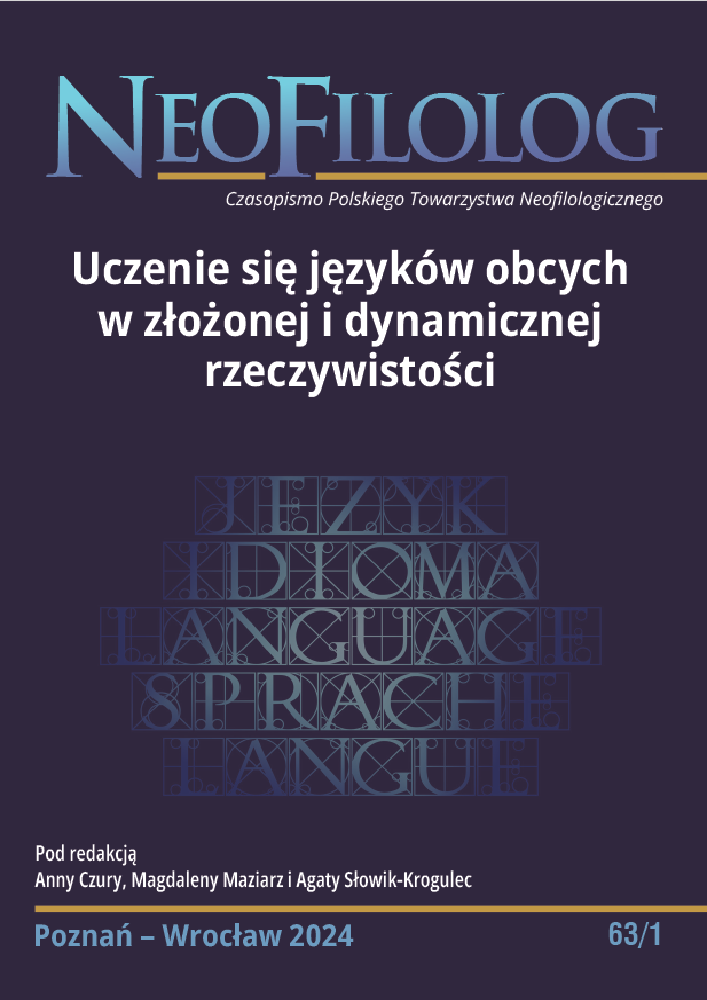Abstrakt
Over the past decades, the understanding of motivation has undergone significant transformations. Departing from its perception as a stable variable (Gardner, 1985), it has evolved into a nonlinear concept with varying degrees of intensity. Motivation is now recognized as one of many complex dynamic systems (Larsen-Freeman, 2016) characterized by nonlinearity, chaos, unpredictability, sensitivity to initial conditions, openness, self-organization, and responsiveness to feedback and adaptation (Larsen-Freeman, 1997: 142). This article aligns itself with this context and presents an understanding of motivation that assumes nonlinearity, variability, and dynamism. Results of a study involving the observation of the phenomenon of motivation variability under the influence of a pedagogical intervention are presented. The theoretical framework for the conducted research is the L2 Motivational Self-system proposed by Zoltan Dörnyei.
Bibliografia
Chomsky N. (1986), Knowledge of language: Ist orgin, nature and use. Westport: Greenwood.
Csizér K. (2017), Motivation in the L2 classroom, (w:) Loewen S., Sato M. (red.), The Routledge handbook of instructed second language acquisition. New York – London: Routledge, s. 418–432. DOI: https://doi.org/10.4324/9781315676968-23
Deci E.L., Ryan R.M. (1985), Intrinsic Motivation and Self-Determination in Human Behavior. Nowy Jork: Plenum. DOI: https://doi.org/10.1007/978-1-4899-2271-7
Dewey J. (1938/1963), Experience and education. New York: Macmillan Company.
Dörnyei Z., Csizér K., (1998), Ten commandments for motivating language learners: Results of an empirical study. „Language Teaching Research”, nr 43/1, s. 1–15.
Dörnyei Z., Ottó I. (1998), Motivation in action: A process model of L2 motivation. „Working Papers in Applied Linguistics“, nr 4, s. 43–69.
Dörnyei Z. (2001), Motivational strategies in the language classroom. Cambridge: Cambridge University Press. DOI: https://doi.org/10.1017/CBO9780511667343
Dörnyei Z. (2009), The L2 Motivational Self System, (w:) Dörnyei Z., Ushoida, E. (red.), Motivation, Language, Identity and the L2 Self. Bristol: Multilingual Matters, s. 9–42. DOI: https://doi.org/10.21832/9781847691293-003
Dörnyei Z., Csizer K., Nemeth N. (2006), Motivation, Language Attitudes and Globalisation: A Hungarian Perspective. Clevedon: Multilingual Matters. DOI: https://doi.org/10.21832/9781853598876
Dörnyei Z., MacIntyre P., Henry A. (2015), Motivational dynamics in language learning. Bristol: Multilingual Matters. DOI: https://doi.org/10.4324/9781315772714
Frijda N. (1986), The emotions. Cambridge: Cambridge University Press.
Gardner R.C., Lambert W.E. (1972), Attitudes and Motivation in Second Language Learning. Rowley, MA: Newbury House Publishers.
Gardner R.C. (1985), Social Psychology and Language Learning: The Role of Attitude and Motivation. London: Edward Arnold.
Gould D., Damarjian N., Greenleaf C. (2002), Imagery training for peak Performance, (w:) Van Raalte J.L., Brewer B.W. (red.), Exploring Sport and Exercise Psychology. Washington, DC: American Psychological, s. 55–82. DOI: https://doi.org/10.1037/14251-004
Hotho S. (2000), “Same” or “different”? A comparative examination of classroom factors in second language settings. „Foreign Language Annals”, nr 33, s. 320–329. DOI: https://doi.org/10.1111/j.1944-9720.2000.tb00609.x
Kozielecki J. (1981), Psychologiczna teoria samowiedzy. Warszawa: PWN.
Larsen-Freeman D. (2016), Classroom-oriented research from a complex systems perspective. „Studies in Second Language Learning and Teaching”, nr 6 (3), s. 377–393. DOI: https://doi.org/10.14746/ssllt.2016.6.3.2
Larsen-Freeman, D. (1997), Chaos/complexity science and second language acquisition. „Applied Linguistics”, nr 18(2), s. 141–165. DOI: https://doi.org/10.1093/applin/18.2.141
Lewis M. (1993), The lexical approach. England: Thomson Heinle.
Lewis M. (2002), Implementing the Lexical Approach: Putting Theory Into Practice. England: Thomson Heinle.
Nerlicki K. (2018), Formuły rutynowe w słownikach i uzusie – na przykładzie niemiecko-polskim i polsko-niemieckim. „Applied Liguistics Papers” nr 25/3, s. 43–59. DOI: https://doi.org/10.32612/uw.25449354.2018.3.pp.43-59
Pawlak M. (2012), Individual differences in language learning and teaching: Achievements, prospects and challenges, (w:) Pawlak M. (red.), New perspectives on individual differences in language learning and teaching. New York: Springer, s. 19–26. DOI: https://doi.org/10.1007/978-3-642-20850-8
Pawlak M. (2017), Individual difference variables as mediating influences on success or failure in form-focused instruction, (w:) Piechurska-Kuciel E., Szyszka M., Szymańska-Czaplak E. (red.), At the crossroads: Challenges of foreign language learning. Heidelberg: Springer Nature, s. 75–92. DOI: https://doi.org/10.1007/978-3-319-55155-5_5
Pawlak M. (2020), Strategie motywacyjne w uczeniu się i nauczaniu języka obcego, (w:) Gabryś-Barker D., Kalamarz R. (red.), Postrzeganie i rola motywacji w procesie glottodydaktycznym. Perspektywa nauczyciela i ucznia. Katowice: Wydawnictwo Uniwersytetu Śląskiego, s. 15–34.
Williams M., Burden R. (1997), Psychology for language teachers. Cambridge: Cambridge University Press.
Wray A. (2002), Formulaic Language and the Lexicon. Cambridge: Cambridge University Press. DOI: https://doi.org/10.1017/CBO9780511519772
Wray A. (2008), Formulaic Language: Pushing the Boundaries. Oxford: Cambridge University Press.
Vroom V. (1994), Work and Motivation. New Jersey: John Wiley & Sons.
Young P.T. (1949), Emotion as disorganized response–A reply to Professor Leeper. „Psychological Review“, nr 56, s. 184–191. DOI: https://doi.org/10.1037/h0054176
Licencja
Prawa autorskie (c) 2024 Magdalena Białek

Utwór dostępny jest na licencji Creative Commons Uznanie autorstwa – Bez utworów zależnych 4.0 Międzynarodowe.
Przedstawiany utwór (artykuł) upubliczniany jest na podstawie umowy z autorem i na licencji Creative Commons Attribution-NoDerivatives 4.0 International (CC BY-ND 4.0).
Użytkownicy mają obowiązek podania wraz z rozpowszechnionym utworem, informacji o autorstwie, tytule, źródle (odnośniki do oryginalnego utworu, DOI) oraz samej licencji;
- bez tworzenia utworów zależnych,
- utwór musi być zachowany w oryginalnej postaci.
Uniwersytet im. Adama Mickiewicza w Poznaniu zachowuje prawo do czasopisma jako całości (układ, forma graficzna, tytuł, projekt okładki, logo itp.).

